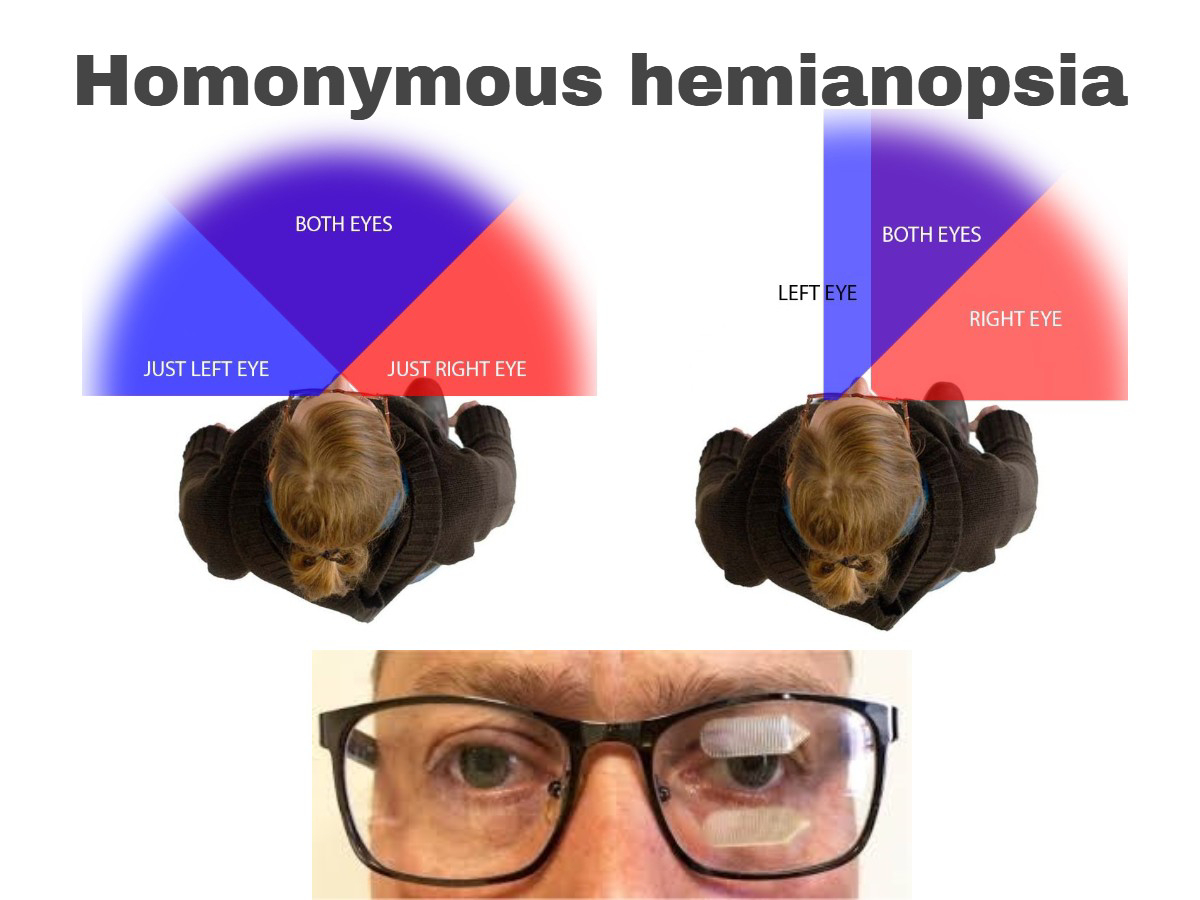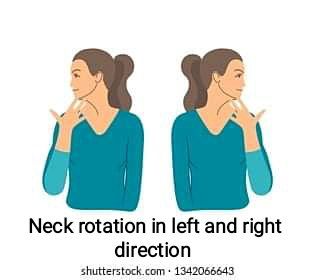Imagine you are able to see and perceive only the half part ( left or right part) of the complete picture of a beautiful view. In order to perceive the complete picture, you need to do compensatory head turns all the time. This kind of symptoms is called as homonymous hemianopia, where patients are able to see only half of the complete picture due to impairment in visual field areas. In cases like post-chiasmal lesion, posterior cerebral artery haemorrhage or infarct and traumatic head injury, this visual field loss symptoms doesn't come into major consideration in rehabilitation process at initial recovery stage. In many cases, even patients doesn't complain about visual field loss. During rehabilitation of head injury or brain injury patients, major focus always goes on the motor, balance, coordination, speech impairments. Visual field impairment is neglected or not been evaluated properly or is considered at last in rehabilitation phase.
Lesions of the primary visual cortex give rise to dense, congruous hemianopic field defects. Occlusion of the posterior cerebral artery supplying the occipital lobe is most common cause of total homonymous hemianopia.
Anatomically the visual system is contained in the supratentorial compartment. It is composed of peripheral receptors in the retina, central pathways and cortical centres. Patients presenting with visual impairment require a systematic examination, not only of vision, but also of the pupillary response, eye movements.
A unilateral post-chiasmal lesion leaves the visual acuity in each eye unaffected, although the patient may read the letters on only the left or right half of the eye chart (hemianopia). Damage to the optic radiations in the temporal lobe (Meyer's loop) produces a superior quadrantic homonymous hemianopia, whereas injury to th optic radiations in the parietal lobe results in an inferior quadrantic homonymous hemianopia.
Symptoms of patients with homonymous hemianopia :
- Failing to notice things on the affected side, therefore, there is a chance of patient bumping into things.
- Drifting in a direction away from the affected visual field while walking.
- Tendency to turn the head or body away from the affected visual field side (hemianopia side). Gradually patient starts to neglect or become inattentive towards affected side.
- Frustration when reading because patient fail or miss to pick the starting of the next line.
- Patient doesn't notice any objects on a table or any platform and even food on a plate on the affected visual side.
- Faces difficulty and takes longer time in everyday task such as doing house chores, crossing a road, finding object. It becomes difficult and unsafe to do few activities like kitchen work, driving a scooter or car.
Hemianopia Rehabilitation
A) Educating patient and relatives :
1) Aim is to improve awareness of the area of visual field loss. Learn strategies to promote the patient's ability to scan in the area of deficit. For example, if patient is a case of right acute posterior cerebral artery territory infarct (Occipital lobe affected) then patient will show symptoms of loss of left eye temporal visual field loss and right eye nasal field loss.
2) Compensatory strategies :
- To perceive complete picture of his surroundings/ environment : the patient should be taught to turn his head to the affected visual field while scanning the environment.
- Implement above method in all daily ADL activities like during eating, searching for any object, bathing.
- Teaching self monitoring strategies which includes anticipation of error causing situations, checking or double checking activity, pacing response in familiar and unfamiliar environment, stimulus reduction i.e avoiding clutters and organizing daily used objects in specific patterns.
- Teaching situational strategies which includes scanning of things or environment in an organized manner (taking your own time) when searching for any object. All these strategies will reduce confusion, decrease time for searching things, improve self esteem of patient, reduce chances of mistakes and dependency on others.
- When reading a book, the client can make an habit of keeping a colourful contrast book mark on the left hand side of the page i.e. on the start on the line. This will help the patient to find the start of the next line quickly and encourage to continue reading from the start of the next line.
3) Relatives should talk to patient or give any object to patient from affected side because this will encourage the patient to look towards the affected visual field area.
B) Therapeutic Exercises :
1) Neck exercises :
Note : Exercises to be performed in a well lighted room. Neck exercises should be performed 10 counts each for 2 to 3 times a day.
- Neck flexion and extension
- Neck left and right lateral flexion
- Neck left and right rotation
2) Eye muscle exercises : It helps to prevent spatial inattention of patient to the affected visual field side. It encourages the patient to look towards the affected visual field side while performing activities of daily living and avoid compensatory neck movements. It might also help to prevent disuse/inactivity of eye muscles on affected side.
Patient will be focusing on a finger tip or a specific object and the therapist or relative will be moving the object in mentioned direction. Exercises to be performed 10 counts each for 2 to 3 times a day.
- Left to right and right to left eye movement with head in static position.
- Up and down eye movement with head in static position.
- Diagonal eye movement with head in static position.
- Converge and diverge eye movement (Far and near focusing).
Note : Perform eyen movement slowly. Patient should be able to clearly see and track the moving object.
3) Later, above eye muscles exercises should be performed with alternate eye blinded/covered with one hand or a patch. Instruct patient Perform eyen movement slowly. Patient should be able to clearly see and track the moving object.
C) Visual field restoration : Visual restoration therapy (VRT)
VRT addresses the restoration of lost vision, helps to recover visual functions and enlarge the visual field. Evidence says this technique helps to reactivate surviving neurons of the partially damaged area of brain. This is performed with both eyes.
VRT is a training software which runs on personal computers and is carried out at the patient's home (provided by NovaVision, Magdeburg). VRT projects stimuli in areas of residual vision i.e. partially defective areas located typically between the intact and the blind parts of the visual field. Patient have to press a key on keyboard whenever they detected the stimulus which is presented in or near the areas of residual vision. Training session was twice daily for half an hour each during a 6 months period.
Other modified home method without computer use : Bright light or torch light is intermittently flashed on the affected visual field side. Flashing light stimulus from an angle towards the eye and not directly on eye. Moving the light stimulus from centre of eye to the affected visual field. Instruct the patient to keep moving the eye towards the direction of light stimulus being perceived. Instruct patient to identify the direction from which the light stimulus or flashing. Encourage the patient to do eye movement towards perceived light stimulus. This exercise should also be performed with one eye by blinding or covering the other eye with a patch.
D) Functional activities :
Functional activities helps to improve eye hand coordination and also helps to activate vestibulo-ocular reflex. Following activities can be given :
1) Throwing large size ball towards a target (i.e. in bucket) and/or tossing plus catching of ball by patient. Start by placing the bucket at center of patient and then progressively keeping the bucket at distance (away from center) in both left and right direction, thereby, covering complete visual field. Perform above activity for 10 counts for atleast 2 times a day.
2) Patient should pass the ball to a person standing behind him. Patient should do trunk rotation and pass the ball from left to right or vice versa direction. Instruct the patient to look at the person standing behind while passing the ball. Perform this activity in sitting or standing position. Perform it for 10 counts in each direction for atleast 2 times a day.
3) Various game activities can be played like : balloon tossing in air, connecting number dots and forming a picture, stringing beads, playing building block activities, paper-pattern cutting, buttoning and unbuttoning shirt, hitting a suspended ball with a bat, puzzle activities etc.
4) Reachout activity at various angles :
Perform it in sitting position. Patient's relatives should place their hand at various distance and height with respect to patient's eye level i.e. above, below, far, near, left and right directions. Instruct patient to touch or give a clap to your hand which is placed ar various distance and height. Encourage patient to concentrate and perform eye and neck movements to reach for your hand to touch. Perform reachout activity for 10 more counts with alternate hand each.
Summary of important points for neurological visual field loss impairments :
- Poststroke visual field impairment affects activities of daily living including self-care, mobility, reading, meal preparation and driving etc.
- Recognising patients with visual field defects after stroke is important as visual rehabilitation may help retain independence and improve quality of life.
- Poststroke or after head injury it is important to diagnose visual field problems in all age groups (particularly in elderly population) to prevent falls.
- Visual rehabilitation therapies need to be individualised and tailored to the specific need of each patient.
Thankyou for reading !!!
Dr.Ashwini D Sangar, Dr.Sheetal Tatar-Dhande, Dr.Pallavi Khadse-Kolhe













Comments
health content writing